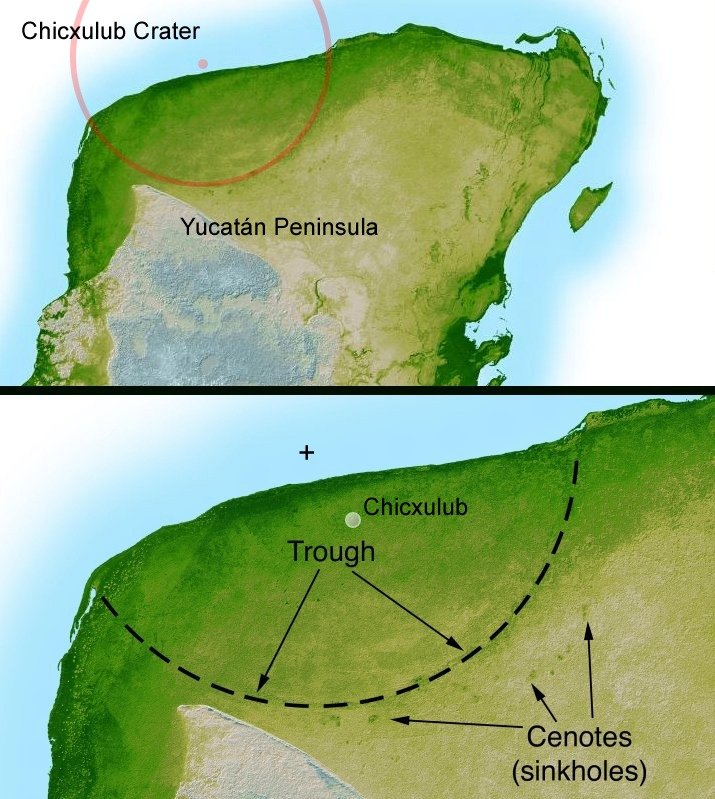Image credit: NASA/JPL-Caltech, modified by David Fuchs
One of the most dramatic turns in the history of the Earth happened 66 or so million years ago, when a space rock known today as the Chicxulub impactor crashed into our home planet. But it was not the impact itself that wiped out the dinosaurs – the creatures that roamed the Earth at the time, but the series of unfortunate climate disruption events that followed.
Today all that reminds us of the deadly rock is a hole in the ground 90 miles across and 12 miles deep. Its center is located on the sea floor off the coast of Mexico’s Yucatan Peninsula near the town of Chicxulub Puerto.
Discovery
Chicxulub crater was discovered – rather by accident – during a 1978 geological survey organized by a Mexican oil company. It was the oil the company was looking for. But it was a crater-looking anomaly that the surveyors have discovered. They shared these findings with the scientific community, but at that time the report did not attract much attention.
Around the same time physicist Luis Alvarez and his son, geologist Walter Alvarez, proposed their asteroid-impact-dinosaur-mass-extinction theory (today we know it as Alvarez hypothesis). Though the theory initially gained some support, many, if not most, scientists were skeptical.
Sadly, it was not until after Luis Alvarez’s death that Glen Penfield, one of the surveyors who discovered the anomaly, joined forces with several geophysicists and the group finally identified Chicxulub feature the likely site of the dinosaur-killing impact. And only just recently, after examining the crater’s material layer by layer and using computer models, scientists were finally able to put together the timeline of the ill-fated events.
The dinosaur – killing impactor
Scientists estimate that the Chicxulub impactor was a rock the size of mount Everest – 10 kilometers (6 miles) across. It entered our atmosphere at a steep angle of 45 – 60 degrees to the horizon at the speed of 45 000 miles an hour (75 000 km per hour). When it smashed into the ground, the impact released the energy of 3 billion nuclear bombs.
And the dinosaurs lived happily ever after. Not.
66 million years ago this giant rock hit the Earth and the impact triggered a chain of catastrophic events that eventually killed dinosaurs and many other living things on our planet.
This is what has probably happened…
First, the rock hit the ocean floor, almost instantaneously vaporizing water and even [surfur-rich!] rock. The rocky vapor injected thousands of tonnes of sulfur into the atmosphere, most likely causing sulphuric acid rains. What’s worse, the suffocating sulphuric acid haze had probably formed, contributing to global cooling and darkening that followed. The ejecta – debris thrown into the air – showered back, heating to scorching temperatures on the way and killing everything within several thousand kilometer radius.
Next, giant tsunamis formed, volcanic eruptions began, fires started, earthquakes began to shake the ground. A huge amount of dust engulfed the Earth, blocking the sunlight and, as a result, killing plants and, eventually, plant-eaters and their predators.
Sulfur-rich dust and soot lingered in the air for years causing a 3 year long ‘Winter’. When the ‘Spring’ finally came, over 75% of all plants and animal species on Earth were gone.
Incidentally, if the rock smashed into the deep sea the water would have absorbed the impact and the dinosaurs – not us – might have been walking the Earth today. Unfortunately, the ocean back then was shallow, and the impact with the rocky bed had devastating – for the dinosaurs – consequences.
Was Chicxulub the only giant impact in the history of the Earth?
Absolutely not. The Solar System is swarming with stray space rocks of all sizes. Most of them reside in the Asteroid Belt, a safe distance away from us. But from time to time some of the rocks escape and crash into planets and moons, including the Earth. The most recent studies, presented at the Goldschmidt Geochemistry Conference 2021, suggest that the early Earth was hit by the Chicxulub-sized impactors once every 15 million years. That is 10 times more often than we previously thought!
Can such a catastrophic collision happen again, at present time? Absolutely yes. As astronomers often put it, “it is not a matter of IF, but WHEN”. But today we, humans, have the knowledge and resources to monitor the so-called Near-Earth objects. We also have ideas on how to push one away from the collision course if any of these objects get too close. One of these ideas will be tested by the new NASA mission, DART, scheduled to launch in July 2021.
(Read more about DART and other upcoming 2021 space missions)
So…it looks like we might be able to ‘science’ our way out of the next dinosaur-wiping-catastrophe. And that’s definitely good news!
Further info
If you enjoyed this Blog post, check out our other posts about asteroids!
- Asteroids, friends or foes? Part one: foes!
- Asteroids, friends or foes? Part 2: friends!
- Space habitats of the future: living inside a spinning asteroid
- Asteroids that grow tails (or everything we know about active asteroids)
- How to study the Earth’s core from… SPACE! Meet asteroid 16 Psyche!
Do you have any further questions? Feel free to leave a comment below or contact our Portable Planetarium team via our Star Dome website http://wonderdome.co.uk. We would love to hear from you!

